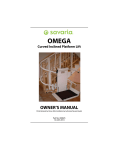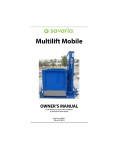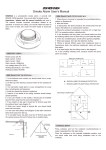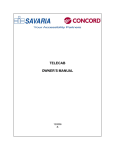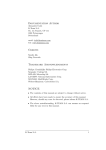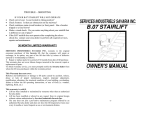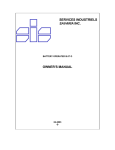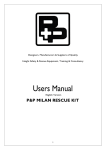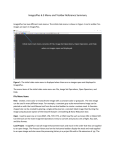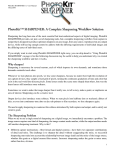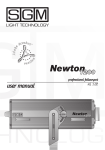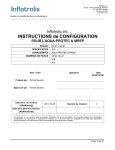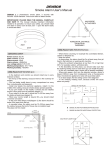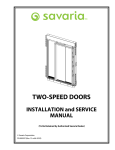Download a User Manual
Transcript
PROLIFT SCL / PROLIFT VOYAGER Accessibility Lifts OWNER’S MANUAL (To Be Retained by Owner After Installation by Authorized Savaria Concord Dealer) ©Savaria Concord Lifts Inc. Part # 000585 (Rev. 05-06-1) IMPORTANT The Prolift SCL or Prolift Voyager must be installed, maintained and serviced by an authorized SAVARIA CONCORD DEALER only! Under no circumstances is anyone other than a trained and authorized Savaria Concord Dealer to install, adjust, service or modify any mechanical or electrical device on this lift. Failure to follow this warning can result in safety systems being compromised or defeated, which can result in serious injury or death. Savaria Concord Inc. accepts no liability for property damage, warranty claims or personal injury, including death, in this circumstance. Lift and elevator passenger safety is the result of countless details in the equipment’s design, manufacture and installation. After installation, reliable operation and continued assurance of safe operation requires regular service and inspection to be carried out at least twice per year, or more frequently where usage or environment dictates or as required by local jurisdiction. The owner is responsible to ensure that regular service and inspections occur in a timely manner. The owner must refer to this manual for operating instructions and precautions for usage of this Prolift SCL or Prolift Voyager. On completion of installation, the dealer must provide the owner with the information below and ensure it is recorded in the owner’s manual. Any service and/or maintenance must also be recorded in the Maintenance Record section of this manual by the authorized Savaria Concord Dealer or the owner. WARRANTY Your Savaria Concord Dealer will provide a copy of the manufacturer’s limited product warranty and documentation relating to any labour warranty offered by your Dealer. FOR OWNER’S RECORDS Installing Dealer: Installing Dealer: Dealer’s Telephone Number: Date Installed: Serial Number: Lift Model: Comments: 2 of 16 PROLIFT SCL /PROLIFT VOYAGER ACCESSIBILITY LIFTS OWNER’S MANUAL TABLE OF CONTENTS 1. GENERAL SPECIFICATIONS 4 2. STANDARD FEATURES 6 3. OPTIONAL FEATURES 8 4. OPERATING THE ELEVATOR FROM THE LANDING CONTROLS 9 5. OPERATING THE ELEVATOR FROM THE CAB CONTROLS 11 6. POWER FAILURE AND EMERGENCY LOWERING 12 7. EMERGENCY LIGHT 13 8. MANUAL LOWERING DEVICE (MACHINE ROOM) 13 9. EMERGENCY HANDS - FREE PHONE (OPTIONAL) 14 10. MAINTENANCE AND INSPECTION CHECKS 15 11. MAINTENANCE RECORD 16 THIS PRODUCT IS DESIGNED AND MANUFACTURED TO EXACT SPECIFICATIONS. MODIFICATIONS OF THIS PRODUCT IN ANY WAY CAN BE DANGEROUS AND WILL VOID THE WARRANTY. 3 of 16 1. GENERAL SPECIFICATIONS PROLIFT SCL Load Capacity 550 lbs. (250 kg), 750 lbs. (341 kg), 1000 lbs. (454 kg) Rated Speed 30 feet per minute (0.15 m/s) (Nominal) Power Supply NOTE: Amperage may vary depending on individual units. Verify requirements prior to installation of power supply. 208 volt, three phase, 30 amps or 230 volt, single phase, 50 amps Drive System 1:2 Cable Hydraulic 35” x 48” (889 mm x 1219 mm) Cab Size 35” x 54” (889 mm x 1372 mm) 35” x 60” (889 mm x 1524 mm) Maximum Travel 12 feet (1 m) Maximum # of Stops 4 stops Pit Depth Required 8” (203 mm) minimum up to 36” (914 mm) Minimum Overhead Clearance 92” (2337 mm) Control System Constant Pressure Floor Selection Magnetic Selector Flooring Material Plywood Control Panel Finish Stainless Steel Hall Station Finish Stainless Steel Motor 3 HP (2.24 kW) Cab Panel Finish Standard Solid Melamine Panels Lighting Supply 115 volt, 60 cycle, 15 amps Clear Anodized Aluminum Cab Trim Emergency Alarm and Stop Buttons with Emergency Battery Back-up for Cab Lighting and Lowering Standard Features Four Recessed Incadescent Down Lights Metal Push Buttons with Illuminated Haloes Stainless Steel Handrail White Egg Crate Ceiling 4 of 16 PROLIFT VOYAGER Load Capacity 750 lbs. (341 kg), 1000 lbs. (454 kg), 1400 lbs. (635 kg) Rated Speed 30 feet per minute (0.15 m/s) (Nominal) Power Supply NOTE: Amperage may vary depending on individual units. Verify requirements prior to installation of power supply. 208 volt, three phase, 30 amps or 230 volt, single phase, 50 amps (5 HP motor) Drive System 1:2 Cable Hydraulic 47” x 60” (1194 mm x 1524 mm) Cab Size 42” x 60” (1067 mm x 1524 mm) 35” x 84” (889 mm x 2134 mm, max. 1000 lbs load capacity) Maximum Travel 36 feet (10.97 m) Maximum # of Stops 5 stops Pit Depth Required 14” (356 mm) minimum up to 24” (609 mm) Minimum Overhead Clearance 96” (2438 mm) Control System Constant Pressure or Single Automatic Push Floor Selection Magnetic Selector Flooring Material Plywood Control Panel Finish Stainless Steel Hall Station Finish Stainless Steel Motor 3 HP (2.24 kW) or 5 HP (3.73 kW) Cab Panel Finish Standard Solid Melamine Panels Lighting Supply 115 volt, 60 cycle, 15 amps Automatic Timed in Car Lighting “Car in Use” Illuminated Hall and Car Buttons Digital Floor Indicator in Cab Standard Features Emergency Alarm and Stop Buttons with Emergency Battery Back-up for Cab Lighting and Lowering Four Recessed Incadescent Down Lights Stainless Steel Handrail White Egg Crate Ceiling 5 of 16 2. STANDARD FEATURES 1) Cab Key Switch (Figure 1-A) The key switch turns the cab controls ON and OFF. It is provided to limit the use of the elevator to authorized persons only. 2) Cab Operating Panel Buttons (Figure 1-B) Automatic Control The Automatic Control Panel buttons facilitate the UP/DOWN movement of the cab between landings. Once the selected landing button is pressed, the cab will automatically move to the landing. The cab will stop when the selected landing is reached. A B Constant Pressure Control The Constant Pressure Control Panel buttons facilitate the UP/DOWN movement of the cab between landings. The selected landing button must be pressed and held until the cab moves to the landing. The cab will stop when the button is released or when the selected landing is reached. 3) D E Door Open Button (Figure 1-C) The elevator door/gate will close automatically after a pre-set adjustable time of 8 seconds. This button can be pressed to open the door/gate when the cab is at a landing. 4) C Figure 1 3 Stop COP Panel Emergency Stop Button (Figure 1-E) The button can be set to Stop at any time to stop the cab and activate the alarm buzzer. 6 of 16 5) Alarm Button (Figure 1-D) The button can be pressed at any time to sound the alarm in case of an emergency. If equipped with the Hands-Free Telephone, hold down the button for approximately 3 to 10 seconds to activate the telephone line. Refer to section 9 for more details. 6) Handrail A single handrail is mounted on the Cab Operating Panel side of the cab. 7) Emergency Light The COP emergency light remains ON in the event of a main power failure. The emergency light uses a Battery Back-Up system with an automatic recharger. 8) Landing Hall Call Station Controls (Figure 2) Hall Call Stations are installed at all landings to move the cab to the landing from which it is being called. An optional key switch limits the elevator’s use to authorized persons only. 9) Landing Door and/or Gate Interlock The Landing Door/Gate lock prevents the Figure 2 Hall Call Station movement of the cab unless the door/gate is in the closed and locked position. If the door/gate is not completely closed, the cab will not move. 10) Emergency Battery Operation In the event of a building power failure, the door/gate system is provided with an temporary power back up system to continue the opening operation for a number of times. On resuming normal building power, the back up system will turn OFF and begin automatic recharging. 7 of 16 3. OPTIONAL FEATURES Automatic Door Opener a) Press the Landing Hall Call button to call the elevator. The entrance door will open automatically once the elevator stops at the landing. b) Press the Remote Control (if equipped) to open the entrance door once the elevator stops at the landing. c) Push ’n’ Go allows the entrance door to open automatically with a slight push to the door itself. The door timer is inoperative when this feature is activated. Automatic Gate Opener a) Press the Landing Hall Call button to call the elevator. The Gate will open automatically once the elevator stops at the landing and the entrance door is fully open. b) Manually open the entrance door, the Gate will open automatically once the entrance door is fully open. NOTE If the cab is equipped with a gate, the gate must be closed after exiting the cab. If not, all controls will remain inoperable. An “entry” and “exit” timer allows approximately nine seconds before the hall buttons become operational. This delay allows time for a person to enter/exit the cab. 8 of 16 4. OPERATING CONTROLS THE ELEVATOR FROM THE LANDING Automatic Operation 1) Insert the key (if equipped) into the switch on the Hall Call and turn the key to the ON position. 2) Press the Hall Call button once and release. The elevator will automatically come to your landing. 3) Turn the key (if equipped) to the OFF position and remove the key. 4) If required, turn the door handle and pull the door open. 5) If the cab is equipped with a manual gate, slide the gate open and enter the cab. 6) Once inside the cab, close the gate, insert the key (if equipped) into the key switch, and turn the key to the ON position. NOTE When using the landing controls, the cab can only be moved (called) to the level from which you are calling. When using the control buttons in the cab, the cab can be moved to any level. WHEELCHAIR WHEELS MUST BE LOCKED AT ALL TIMES WHEN THE ELEVATOR IS MOVING 9 of 16 Constant Pressure Operation 1) Insert the key (if equipped) into the switch on the Hall Call and turn the key to the ON position. 2) Press and maintain constant pressure on the Hall Call button until the cab stops at your landing. To stop the cab at any point simply release the Hall Call button. 3) Turn the key (if equipped) to the OFF position and remove the key. 4) If required, turn the door handle and pull the door open. 5) If the cab is equipped with a manual gate, slide the gate open and enter the cab. Once inside the cab, close the gate, insert the key (if equipped) into the key switch, and turn the key to the ON position. If the elevator is equipped with our Automatic Pro-Door follow this procedure: a) Stay clear the swing of the landing door. The door will “chime” and then swing open automatically. If cab is equipped with an automatic gate, the gate will open at this time. The door and gate are timed to stay open for a few seconds. Enter the cab. Once inside the cab, lock wheelchair wheels. If the elevator is equipped with our Manual Pro-Door follow this procedure: b) Pull on the door handle and open the landing door. If the cab is equipped with a gate, slide the gate open at this time and enter the cab. Once inside the cab, close the landing door and then the gate. Lock wheelchair wheels. 10 of 16 5. OPERATING THE ELEVATOR FROM THE CAB CONTROLS Automatic Operation 1) Insert the key (if equipped) into the switch located in the Cab Operating Panel. Turn the key to the ON position. 2) Press the selected Landing button once and release. The elevator will automatically travel to and stop at the selected landing. 3) Turn the key (if equipped) to the OFF position and remove the key. 4) Unlock the wheelchair wheels and exit the cab (if applicable). Constant Pressure 1) Insert the key (if equipped) into the switch located in the Cab Operating Panel. Turn the key to the ON position. 2) Press and maintain constant pressure on the selected Landing button to move the elevator. Maintain constant pressure until the elevator automatically stops at the desired landing. To stop the elevator at any point simply release the Hall Call button. 3) Release the Landing button when the elevator arrives at the landing. 4) Turn the key (if equipped) to the OFF position and remove the key. 5) Unlock the wheelchair wheels and exit the cab (if applicable). If the elevator is equipped with our Automatic Pro-Door follow this procedure: a) The gate will open and the door will “chime” and then swing open automatically. The door and gate are timed to stay open for a few seconds. Exit the cab. The gate and door will close. If the elevator is equipped with our Manual Pro-Door follow this procedure: b) If cab is equipped with a gate, slide the gate open at this time and then open the manual swing landing door. Exit the cab. Close the gate and then the landing door. 11 of 16 6. POWER FAILURE AND EMERGENCY LOWERING In the event of a power failure, the elevator is equipped with a Battery Back-Up system that allows the user to lower the elevator from the inside of the cab. This device operates on batteries and is only activated if a main power supply failure occurs. The operation is as follows: 1) a) For elevators with automatic operation, press any Landing button below the floor where the elevator is located. b) For elevators with constant pressure operation, press any Landing button below the floor where the elevator is located and maintain constant pressure until the cab is level with the lower landing. 2) On arrival at the selected floor, the landing door will automatically unlock. 3) If the door is equipped with an automatic gate, the gate will open. 4) Release the button, remove the key, open the manual gate (if equipped) and exit the cab. 12 of 16 7. EMERGENCY LIGHT In the event of a main power failure, the emergency cab light will light automatically. 8. MANUAL LOWERING DEVICE (MACHINE ROOM) In the event of power failure, the cab can be moved to a lower level manually by using the following procedures: 1) Obtain the key to unlock the door to the machine room where the elevator pump unit is located (if applicable). 2) Instruct the person(s) in the elevator to remain calm and stay well back from the door of the elevator. Ease their concern by telling them your intentions. 3) Switch the main disconnect switch for the main power supply to the elevator pump unit to the “OFF” position 4) If equipped, use the owner’s key to unlock the Controller Tank cover. The EPV Valve is located inside. 5) Manual Lowering Knob (pull to lower lift) Locate the red manual Figure 3 EPV Valve release knob on the EPV Valve and pull the knob to lower the cab (refer to Figure 3). Maintain a constant pull on the knob until the elevator reaches the lowest landing and stops automatically. (Although you may not be able to see the elevator, this is readily detected, as there will be no further noise as the oil flows to the reservoir). 13 of 16 6) To exit the cab, open the lower landing door and assist the passenger(s). 7) After passenger(s) have exited the cab, remove the cab key. Make sure the landing door is closed, reconnect the disconnect switch in the machine room and lock the door. 9. EMERGENCY HANDS - FREE PHONE (OPTIONAL) 1) If your lift is equipped with an Emergency Hands-Free Telephone, press and hold down the Alarm button to activate the phone line. A short time delay (adjustable by the installing technician) will occur. 2) Release the Alarm button once the call is picked up by the telephone line. The system will automatically dial out to a pre-programmed telephone number as set up by the installing technician 14 of 16 10. MAINTENANCE AND INSPECTION CHECKS Regular maintenance will keep your elevator in proper operating condition. Please remember, as the owner of this elevator, you are responsible for making sure that maintenance and upkeep are done on a regularly scheduled basis. To ensure proper operating condition of your unit, the items listed below must be inspected and, if necessary, serviced a minimum of twice per year. Additional inspections may be required depending on usage. 1) Tighten all rail and cab fastening bolts. 2) Lubricate the door hinges and adjust the door closure if required. 3) Lubricate the rails with light grease, such as white lithium. 4) Inspect the travelling cable for wear. Replace if any cuts or damage to the jacket are evident. 5) Check for any hose/pipe leaks. Replace and/or tighten the fittings to correct any hydraulic leaks found. 6) Check the fluid level of the pump reservoir (with the elevator at its lowest landing), and fill as required. (Use Grade 32 Hydraulic Oil). There must be at least 1” inch of oil on the dipstick. 7) Tighten any hose connections or bleeder valves found loose. Check the hydraulic cylinder (jack) for any leaks. If necessary, the packing seals may have to be replaced. 8) Replace the batteries inside the control panel as indicated on the battery label. 9) To perform the required maintenance to the Kwiklock or Pro-lock (if equipped), call your Authorized Savaria Concord Dealer. 10) Activate and test the safety mechanism. UNDER NO CIRCUMSTANCES SHOULD THE PUMP CONTROLS OR VALVE SETTINGS BE ADJUSTED EXCEPT BY AN AUTHORIZED CONCORD DEALER 15 of 16 11. MAINTENANCE RECORD It is recommended that the Owner update the Maintenance Record after each service call. Date Time Reason for Call Comments 16 of 16 Dealer

















